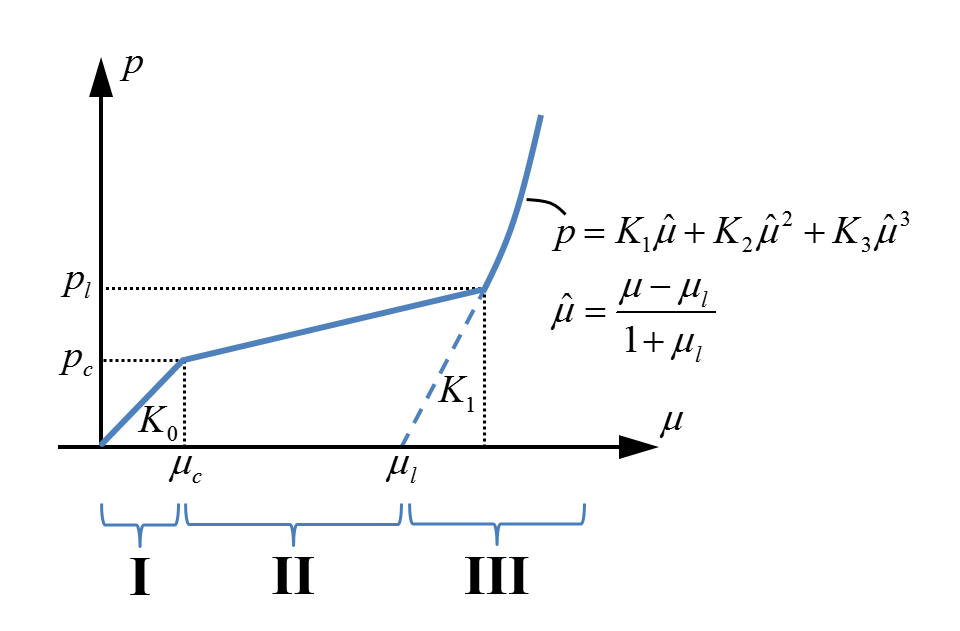MAT_HJC_CONCRETE
Material properties
"Optional title"
mid, $\rho$, $G$
$A$, $B$, $n$, $C$, $f_c$, $T$, $\dot\varepsilon_0$, $ef_{min}$
$sf_{max}$, $p_{\mathrm{c}}$, $\mu_{\mathrm{c}}$, $p_{\mathrm{l}}$, $\mu_{\mathrm{l}}$, $D_1$, $D_2$, $K_1$
$K_2$, $K_3$, erode
Parameter definition
Description
This is the Holmquist-Johnson-Cook concrete model. In the positive pressure regime the deviatoric flow stress $\sigma_y$ is defined as:
$\sigma_y = fc \cdot \mathrm{min} \left[ sf_{max}, \left( A (1-D) + B \left( \frac{p}{fc} \right)^N \right) \cdot \left( 1 + C \mathrm{ln} \left( \frac{\dot\varepsilon}{\dot\varepsilon_0} \right) \right) \right]$
and in the negative pressure (tensile) regime as:
$\sigma_y = fc \cdot A (1 + p/T) \cdot (1-D) \cdot \left( 1 + C \mathrm{ln} \left( \frac{\dot\varepsilon}{\dot\varepsilon_0} \right) \right)$
where $p$ is the current pressure and $0 \leq D \leq 1$ is the damage. Damage grows during crushing and deviatoric plastic flow according to:
$\displaystyle{\dot D = \frac{\dot\varepsilon_p + \dot\mu_p}{\varepsilon_f}}$
$\dot\varepsilon_p$ and $\dot\mu_p$ are the deviatoric and volumetric plastic strain rates, respectively. The failure strain $\varepsilon_f$ is defined as:
$\displaystyle{\varepsilon_f = \mathrm{max} \left( ef_{min}, D_1 \left( \frac{p + T}{fc} \right)^{D_2} \right)}$
The pressure-volumetric strain relationship is divided into three regions (see figure below). Region I is linear elastic and is valid from $p=-T$ to $p=p_c$. The bulk modulus in region I is:
$\displaystyle{K_0 = \frac{p_c}{\mu_c}}$
Region II is a transition region where the plastic compaction $\mu_p$ grows from 0 to $\mu_l$. The compaction stress grows linearly with $\mu_p$, from $p_c$ at $\mu_p=0$ to $p_l$ at $\mu_p=\mu_l$. Also the bulk modulus in region II is interpolated linearly, from $K_0$ at zero compaction to $K_1$ at $\mu_p=\mu_l$.
$\displaystyle{K(\mu_p) = K_0 + (K_0-K_1) \frac{\mu_p}{\mu_l}}$
The material is fully compacted ($\mu_p=\mu_l$) at pressure $p=p_l$. Region III describes the fully compacted material. There are no more voids and the pressure is defined as:
$p = K_1 \hat\mu + K_2 \hat\mu^2 + K_3 \hat\mu^3$
where:
$\displaystyle{\hat\mu = \frac{\mu - \mu_l}{1 + \mu_l}}$

